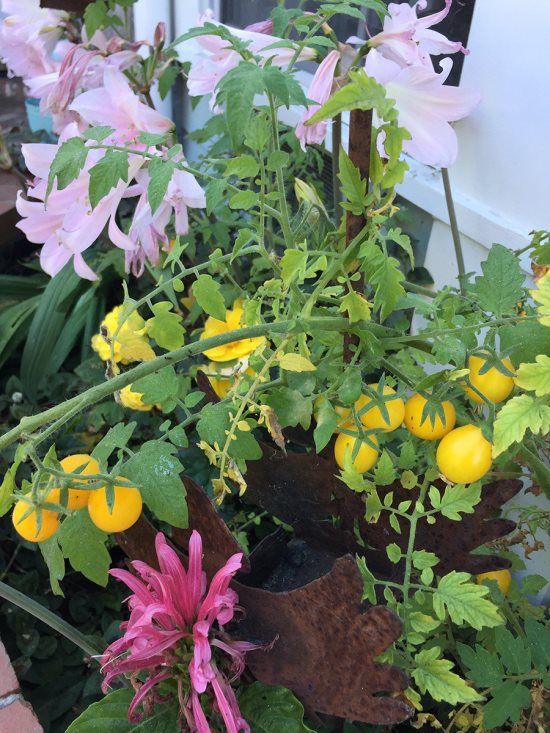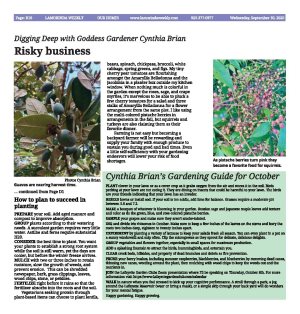|
|
Published September 30th, 2020
|
Digging Deep with Goddess Gardener Cynthia Brian
|
| Risky business |
| By Cynthia Brian |
 |
| Even in a small window box, vegetables and flowers grow well together. Photo Cynthia Brian |
"Farming looks mighty easy when your plow is a pencil, and you're a thousand miles from a cornfield." ~ Dwight D. Eisenhower
 When you bite into a crunchy apple, eat a bunch of juicy grapes, or slather butter on roasted sweet corn, unless you've grown these crops in your personal garden, do you ever wonder about the life of the farmer who provides you with your food? To grow healthy, nutritional produce, farmers work daily, rain or shine, in every season, to provide city dwellers with sustenance. They get paid when they sell their harvest, yet it only takes one natural disaster to destroy their year-long labors and erase the opportunity for remuneration.
When you bite into a crunchy apple, eat a bunch of juicy grapes, or slather butter on roasted sweet corn, unless you've grown these crops in your personal garden, do you ever wonder about the life of the farmer who provides you with your food? To grow healthy, nutritional produce, farmers work daily, rain or shine, in every season, to provide city dwellers with sustenance. They get paid when they sell their harvest, yet it only takes one natural disaster to destroy their year-long labors and erase the opportunity for remuneration.
 Farming is a risky business.
Farming is a risky business.
 A few times when I was a child, our family suffered the fate of a failed harvest. The culprit was usually a heavy rain mildewing the fruit before it could be picked. This year, the demon was the horrific fires with the unending days of suffocating smoke that smoke-tainted the grapes. One hundred percent of our Cabernet Sauvignon will hang on the vines to rot because they cannot be pressed and made into wine. The smoke-taint is so pervasive that the taste of eating a single grape is like licking an ashtray. Most growers of red grapes throughout Northern California are suffering the same fate. There will be no check in the mail. A full year of blood, sweat, and tears up in smoke, literally!
A few times when I was a child, our family suffered the fate of a failed harvest. The culprit was usually a heavy rain mildewing the fruit before it could be picked. This year, the demon was the horrific fires with the unending days of suffocating smoke that smoke-tainted the grapes. One hundred percent of our Cabernet Sauvignon will hang on the vines to rot because they cannot be pressed and made into wine. The smoke-taint is so pervasive that the taste of eating a single grape is like licking an ashtray. Most growers of red grapes throughout Northern California are suffering the same fate. There will be no check in the mail. A full year of blood, sweat, and tears up in smoke, literally!
 With global warming and climate change, farms are going to fail. Food insecurity will become more prevalent, even in abundant America. In the face of natural, financial, and social crisis, now more than ever, we all need to learn to be food resilient by reconnecting to the land and growing our own to supplement what we buy. Urban agriculture is a buffer to economic instability building resilience through biodiversity and organic gardening practices.
With global warming and climate change, farms are going to fail. Food insecurity will become more prevalent, even in abundant America. In the face of natural, financial, and social crisis, now more than ever, we all need to learn to be food resilient by reconnecting to the land and growing our own to supplement what we buy. Urban agriculture is a buffer to economic instability building resilience through biodiversity and organic gardening practices.
 Autumn has arrived and with it the optimal time to plan before planting. Start small. Plant densely and use crop rotation for seasonal vegetables. Intermingle flowers and vegetables. Plants need water or they will suffer and die. Until the rains come, you will need to observe your plantings to ascertain that seeds and roots are not drying out. Before you begin your planting process, planning is essential.
Autumn has arrived and with it the optimal time to plan before planting. Start small. Plant densely and use crop rotation for seasonal vegetables. Intermingle flowers and vegetables. Plants need water or they will suffer and die. Until the rains come, you will need to observe your plantings to ascertain that seeds and roots are not drying out. Before you begin your planting process, planning is essential.
 How to plan to succeed in planting
How to plan to succeed in planting
 PREPARE your soil. Add aged manure and compost to improve absorption.
PREPARE your soil. Add aged manure and compost to improve absorption.
 GROUP plants according to their watering needs. A succulent garden requires very little water. Astilbe and ferns require substantial H20.
GROUP plants according to their watering needs. A succulent garden requires very little water. Astilbe and ferns require substantial H20.
 CONSIDER the best time to plant. You want your plants to establish a strong root system while the soil is still warm, yet the days are cooler, but before the winter freeze arrives.
CONSIDER the best time to plant. You want your plants to establish a strong root system while the soil is still warm, yet the days are cooler, but before the winter freeze arrives.
 MULCH with two or three inches to retain moisture, slow the growth of weeds, and prevent erosion. This can be shredded newspaper, bark, grass clippings, leaves, wood chips, stone, or pebbles.
MULCH with two or three inches to retain moisture, slow the growth of weeds, and prevent erosion. This can be shredded newspaper, bark, grass clippings, leaves, wood chips, stone, or pebbles.
 FERTILIZE right before it rains so that the fertilizer absorbs into the roots and the soil.
FERTILIZE right before it rains so that the fertilizer absorbs into the roots and the soil.
 Vegetarians seeking protein through plant-based items can choose to plant lentils, beans, spinach, chickpeas, broccoli, white cabbage, spring greens, and figs. My tiny cherry pear tomatoes are flourishing amongst the Amaryllis Belladonna and the Jacobinia in a planter box outside my kitchen window. When nothing much is colorful in the garden except the roses, sage, and crape myrtles, it's marvelous to be able to pluck a few cherry tomatoes for a salad and three stalks of Amaryllis Belladonna for a flower arrangement from the same plot. I like using the multi-colored pistache berries in arrangements in the fall, but squirrels and turkeys are also claiming them as their favorite dinner.
Vegetarians seeking protein through plant-based items can choose to plant lentils, beans, spinach, chickpeas, broccoli, white cabbage, spring greens, and figs. My tiny cherry pear tomatoes are flourishing amongst the Amaryllis Belladonna and the Jacobinia in a planter box outside my kitchen window. When nothing much is colorful in the garden except the roses, sage, and crape myrtles, it's marvelous to be able to pluck a few cherry tomatoes for a salad and three stalks of Amaryllis Belladonna for a flower arrangement from the same plot. I like using the multi-colored pistache berries in arrangements in the fall, but squirrels and turkeys are also claiming them as their favorite dinner.
 Farming is not easy but becoming a backyard farmer will be rewarding and supply your family with enough produce to sustain you during good and bad times. Even a little self-sufficiency with your gardening endeavors will lower your risk of food shortages.
Farming is not easy but becoming a backyard farmer will be rewarding and supply your family with enough produce to sustain you during good and bad times. Even a little self-sufficiency with your gardening endeavors will lower your risk of food shortages.
 Cynthia Brian's Gardening Guide for October
Cynthia Brian's Gardening Guide for October
 PLANT clover in your lawn or as a cover crop as it grabs oxygen from the air and stores it in the soil. Birds pecking at your lawn are not eating it. They are dining on insects that could be harmful to your lawn. The birds are your friends indicating that your lawn has an invader.
PLANT clover in your lawn or as a cover crop as it grabs oxygen from the air and stores it in the soil. Birds pecking at your lawn are not eating it. They are dining on insects that could be harmful to your lawn. The birds are your friends indicating that your lawn has an invader.
 RESEED lawns or install sod. If your soil is too acidic, add lime for balance. Grasses require a moderate pH between 5.8 and 7.2.
RESEED lawns or install sod. If your soil is too acidic, add lime for balance. Grasses require a moderate pH between 5.8 and 7.2.
 MAKE a bouquet of whatever is blooming in your garden. Russian sage and Japanese maple leaves add texture and color as do the green, blue, and rose-colored pistache berries.
MAKE a bouquet of whatever is blooming in your garden. Russian sage and Japanese maple leaves add texture and color as do the green, blue, and rose-colored pistache berries.
 SAMPLE your grapes and make sure they aren't smoke-tainted.
SAMPLE your grapes and make sure they aren't smoke-tainted.
 DIG and divide iris rhizomes in October. Make sure to keep a few inches of the leaves on the stems and bury the roots two inches deep, eighteen to twenty inches apart.
DIG and divide iris rhizomes in October. Make sure to keep a few inches of the leaves on the stems and bury the roots two inches deep, eighteen to twenty inches apart.
 EXPERIMENT by planting a variety of lettuces to keep your salads fresh all season. You can even plant in a pot on a sunny windowsill and snip often. Clip the microgreens as they sprout for delicate, delicious delights.
EXPERIMENT by planting a variety of lettuces to keep your salads fresh all season. You can even plant in a pot on a sunny windowsill and snip often. Clip the microgreens as they sprout for delicate, delicious delights.
 GROUP vegetables and flowers together, especially in small spaces for maximum production.
GROUP vegetables and flowers together, especially in small spaces for maximum production.
 ADD a splashing fountain to attract the birds, hummingbirds, and entertain you.
ADD a splashing fountain to attract the birds, hummingbirds, and entertain you.
 CLEAR creek beds, hillsides, and property of dead branches and debris as fire prevention.
CLEAR creek beds, hillsides, and property of dead branches and debris as fire prevention.
 PRUNE your berry bushes, including summer raspberries, blackberries, and blueberries by removing dead canes, thinning new canes, weeding around the plant, then mulching with wood chips to keep the weeds out and the nutrients in.
PRUNE your berry bushes, including summer raspberries, blackberries, and blueberries by removing dead canes, thinning new canes, weeding around the plant, then mulching with wood chips to keep the weeds out and the nutrients in.
 JOIN the Lafayette Garden Clubs Zoom presentation where I'll be speaking on Thursday, October 8th. For more information visit https://www.lafayettegardenclub.com/calendar
JOIN the Lafayette Garden Clubs Zoom presentation where I'll be speaking on Thursday, October 8th. For more information visit https://www.lafayettegardenclub.com/calendar
 WALK in nature when you feel stressed to kick up your cognitive performance. A stroll through a park, a jog around the Lafayette Reservoir (wear or bring a mask), or a simple skip through your back yard will do wonders for your mental fatigue.
WALK in nature when you feel stressed to kick up your cognitive performance. A stroll through a park, a jog around the Lafayette Reservoir (wear or bring a mask), or a simple skip through your back yard will do wonders for your mental fatigue.
 Happy gardening. Happy growing.
Happy gardening. Happy growing. |
 |
| Guavas are nearing harvest time. Photos Cynthia Brian |
 |
| As pistache berries turn pink they become a favorite food for squirrels. Photos Cynthia Brian |
 |
| A fall fountain splashes flanked by a garden of black-eyed Susans. Photos Cynthia Brian |
 |
| Cynthia Brian under a blooming crape myrtle. Cynthia Brian, The Goddess Gardener, is available for hire to help you prepare for your spring garden. Raised in the vineyards of Napa County, Cynthia is a New York Times best-selling author, actor, radio personality, speaker, media and writing coach, as well as the Founder and Executive Director of Be the Star You Are!r 501 c3. Tune into Cynthia's StarStyler Radio Broadcast at
www.StarStyleRadio.com. Buy copies of her best-selling books and receive extra freebies, Chicken Soup for the Gardener's Soul, Growing with the Goddess Gardener, and Be the Star You Are! Millennials to Boomers at
www.cynthiabrian.com/online-store. Cynthia is available for virtual writing projects, garden consults, and inspirational lectures.
Cynthia@GoddessGardener.com
www.GoddessGardener.com |
| |
| |
|
|
|









